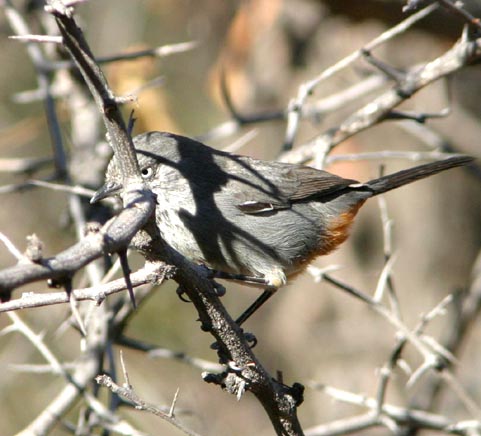
a web page by Don Roberson |
SYLVIDS Sylviidae |
||
|
||
At one time the family Sylviidae included over 400 "Old World warblers." In the Handbook of the Birds of the World series, Bairlein (2006) still listed 270 species in this huge family (after HBW had already split off 145 species of "traditional Old World warblers" into the Cisticolidae, following Sibley & Ahlquist 1990 and others). By then, however, the molecular evidence from studies early in the 21st century led to the "Break-up of the Old World warblers" into more than a dozen new and unexpected families; Cibois et al. (1999, 2001), Barker et al. (2004), Alström et al. (2006), Jønsson & Fjeldså (2006), and others. |
||
We now know these Sylvia "warblers" are actually more closely related to babblers [Timaliidae], and thus these birds are better referred to as Sylvia babblers, or or just sylvids. There was yet another problem. Some thought that the name "Sylviidae" should be suppressed because sylvids are now babblers, not Old World warblers [such a decision can only be taken by the International Commission on Zoological Nomenclature]. Others (summarized in Cibois et al. 2010) propose that Sylviidae now be used as the Family name for the sylvid-babblers, as these include the Sylvia "warblers" for which the Family gets its name. This solution was eventually adopted.
But there were more problems. The babblers themselves were once considered a huge family of over 300 species. More recent research, especially Gelang et al. (2009), led to a "break-up of the Babblers." Cibois et al. (2010) summarized the outlines for five babbler families: tree babblers and scimitar-babblers [Timaliidae], sylvid babblers, parrotbills, and allies [Sylviidae — including the group on this page], white-eyes and allies [Zosteropidae], fulvettas and ground-babblers [Pellorneidae], and laughingthrushes [Leiothrichidae]. That approach was adopted by some recent world checklists. Even more recently, Fregin et al. (2012) liked that approach and proposed even more family splits in the sylvoid assemblage. In contrast, Moyle et al. (2012) confirmed the major lineages but proposed that the ones younger than the early Miocene be relegated to subfamily status [more details on my Babbler page]. I have adopted that approach. Further, the divergence between the Sylvia "warblers" set and the parrotbill & allies clade is quite ancient — estimated at about 20 million years ago (mya; 19.4 mya as to extant lineages; Voelker & Light 2011), and therefore I split the modern "sylvids" into two families that arose in the early Miocene: the Sylviidae [this group] and the Parrotbills & allies [Paradoxornithidae]. It will take some time to determine which approach will be the more widely adopted. |
||
 |
||
Desert Warbler S. nana (which may be composed of several cryptic species) diverged next, at 14.5 mya, and then the remaining two clades at 12.6 mya (Voelker & Light 2011). The attractive Cyprus Warbler (male above in full-page spread, in a great photo by Graham Catley) is in what Voelker & Light (2011) call "Clade 2," a set of sylvids around the Mediterranean and north Africa. Cypress Warbler breeds solely on the island of Cypress but winters along a narrow strip of Red Sea coast from northeast Egypt to northeast Sudan. Rüppell's Warbler (female at above right, also by Graham Catley) is another member of this clade. It breeds from Greece to Turkey, and winters in the Sahel of Chad and Sudan. |
||
|
||
| The final clade reviewed by Voelker & Light (2011) was a set that includes Lesser Whitethroat (above left, yet another nice Graham Catley shot), a widespread hedgerow breeder from Europe to western China [but not Common Whitethroat S. communis (which was in "clade 2")]. This group includes quite a number of African birds, including five species in the former genus "Parisoma" that are embedded within Sylvia (Blondel et al. 1996, Shirihai et al. 2001) and should be merged into Sylvia. One of these is Chestnut-vented Warbler S. subcaeruleum of arid scrub in southwestern Africa (above right). | ||
Two more African species belong here — Abyssinian Catbird Parophasma galinieri and Bush Blackcap Lioptilus nigricapillus — belong here (Moyle et al. 2012). Whether to merge them into genus Sylvia is still uncertain (as is the issue of splitting Sylvia itself up into multiple genera). But the full outlines of this "new" Sylviidae family is now known. Ecology, migration, and identification of the Sylviidae — as now reconstituted — are interesting topics, discussed in depth in Shirihai et al. (2001). I notice, just in looking at the photos, how many shots show a sylvid among thornscrub. But here's a photo that is, instead, among flowers: a lovely male Subalpine Warbler of the western nominate race (and another superb Graham Catley photo). It breeds from Spain to w. Turkey, and along the Mediterranean coast of northwest Africa, and winters primarily in the sahel just south of the Saharan Desert. Its breeding preference is intermediate stages of post-wildfire succession (such as young cork oaks); in winter it uses acacia or tamarisk savanna (Bairlein 2006). |
||
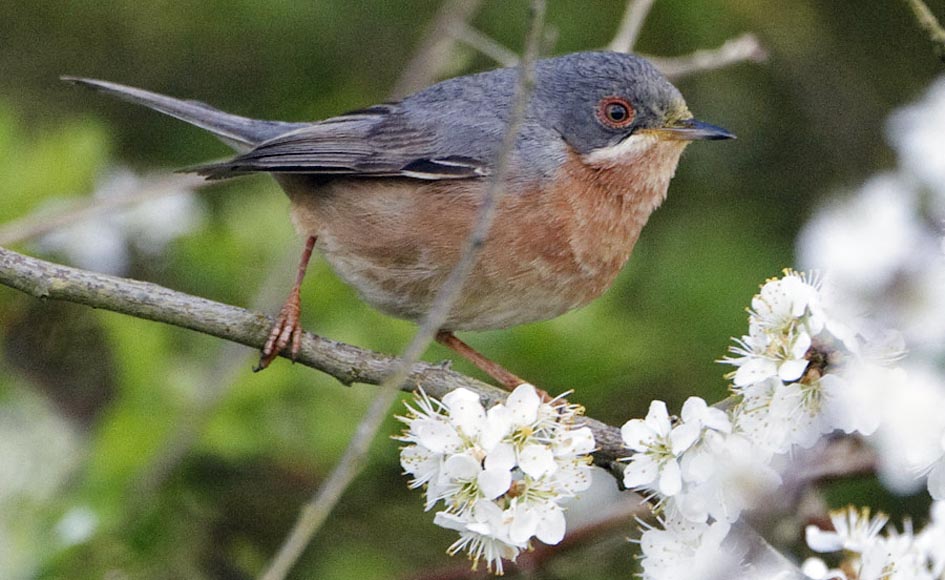 |
||
|
||
Photos: The singing Blackcap Sylvia atricapilla was photographed by Graham Catley at Lincolnshire, U. K. The Sardinian Warbler Sylvia melanocephala was photographed by Blake Matheson at Monfrague, Spain, on 6 Apr 2005. Graham Catley photographed the Cyprus Warbler S. melanothorax at Pissouri, Cyprus, on 11 Apr 2008; the 2nd-cycle female Rüppell's Warbler S. rueppelli also at at Pissouri, Cyprus, on 13 Apr 2008; the Lesser Whitethroat S. curruca at Gibraltar Pt., Lincolnshire, U. K., where it was a vagrant; and the Subalpine Warbler S. cantillans at Humberston, Lincolnshire, U. K., where it also was a rarity. The Chestnut-vented Warbler S. subcaeruleum was near Brandvlei, South Africa, in July 2006.
Bibliographic notes There is no "family book" on all the species that ended up as sylvids but there is a book covering the genus Sylvia — Shirihai et al. (2001) — although I have not yet studied it in detail. I understand that the text is excellent and it is illustrated with great photos. Literature cited:
|
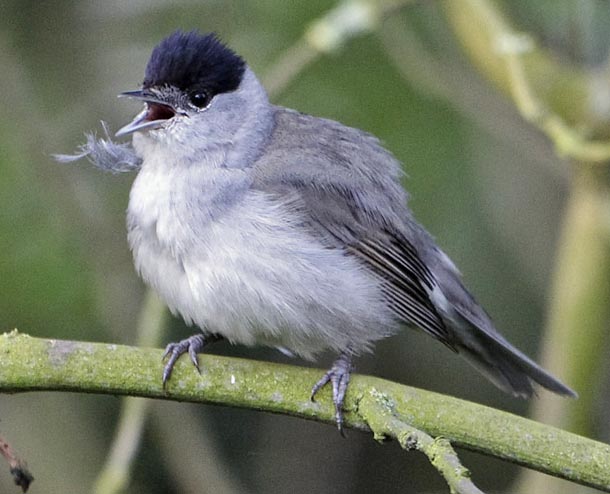 The Sylviidae has a complex history. The base genus is Sylvia, a group of ~18 "warblers" found primarily in Europe, north Africa, and the Middle East. Many are skulking birds of the undergrowth — recalling babblers in this respect — that are often best seen when singing and defending territories. such as this singing male Blackcap (left, in a fine photo by Graham Catley). Other well known Sylvia warblers include Dartford Warbler S. undata of Europe (which reaches southern England and inhabits dense heath) and several species of Whitethroat.
The Sylviidae has a complex history. The base genus is Sylvia, a group of ~18 "warblers" found primarily in Europe, north Africa, and the Middle East. Many are skulking birds of the undergrowth — recalling babblers in this respect — that are often best seen when singing and defending territories. such as this singing male Blackcap (left, in a fine photo by Graham Catley). Other well known Sylvia warblers include Dartford Warbler S. undata of Europe (which reaches southern England and inhabits dense heath) and several species of Whitethroat.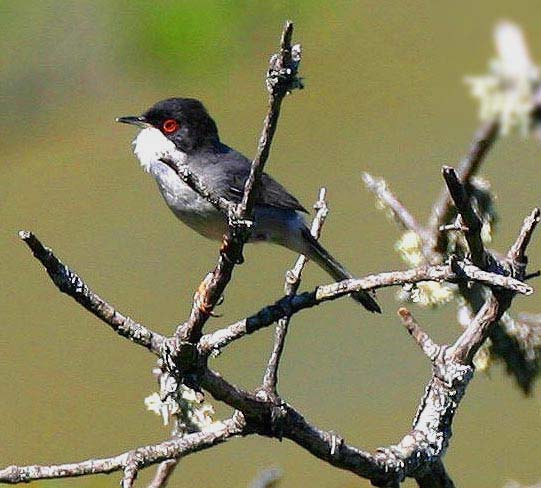 So the Sylviidae still exists as a family, and the familiar sylvids around the western Palearctic are still in that family, even if we must start thinking of them as "sylvid-babblers". The Sardinian Warbler (right, in a nice shot by Blake Matheson) is found around the Mediterranean.
So the Sylviidae still exists as a family, and the familiar sylvids around the western Palearctic are still in that family, even if we must start thinking of them as "sylvid-babblers". The Sardinian Warbler (right, in a nice shot by Blake Matheson) is found around the Mediterranean.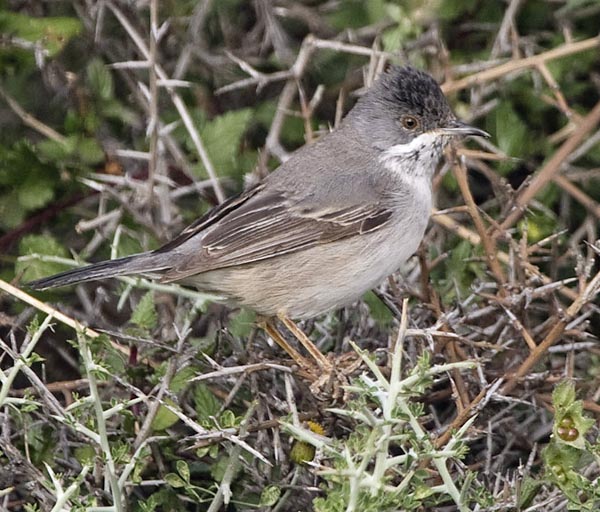 Voelker & Light (2011) undertook a complete review of the genus Sylvia. There are four major clades in this Sylvia, and it could be argued that different generic names should be applied to each clade. The earliest includes Blackcap S. atricapilla and Garden Warbler S. borin, with "speciation of extant species within Clade 1 dated to 14.5 mya and Europe is reconstructed as the most likely ancestral area for this clade. Following the divergences of atricapilla and borin, a sub-Saharan distribution was established , with a subsequent divergence between dohrni (Gulf of Guinea Island endemic) and abyssinicus (broad Afro-tropical distribution)." The first of these latter two species is Dohrn's Thrush-Babbler "Horizorhinus" dohrni, a mysterious endemic to the island of Principe in the nation of Sao Tome & Principe, whose affinities were quite a shock (see Voelker et al. 2009). The second is and Abyssinian (African) Hill-Babbler "Pseudoalcippe" abyssinica [plus presumably Ruwenzori Hill-Babbler "P." atriceps] of east and northeast Africa. These taxa should be placed in genus Sylvia. The hill-babblers were once assigned to genus Illadopsis, but all the other Illadopsis that have been genetically studied prove to be in the subfamily Pellorneinae of the Babbler family.
Voelker & Light (2011) undertook a complete review of the genus Sylvia. There are four major clades in this Sylvia, and it could be argued that different generic names should be applied to each clade. The earliest includes Blackcap S. atricapilla and Garden Warbler S. borin, with "speciation of extant species within Clade 1 dated to 14.5 mya and Europe is reconstructed as the most likely ancestral area for this clade. Following the divergences of atricapilla and borin, a sub-Saharan distribution was established , with a subsequent divergence between dohrni (Gulf of Guinea Island endemic) and abyssinicus (broad Afro-tropical distribution)." The first of these latter two species is Dohrn's Thrush-Babbler "Horizorhinus" dohrni, a mysterious endemic to the island of Principe in the nation of Sao Tome & Principe, whose affinities were quite a shock (see Voelker et al. 2009). The second is and Abyssinian (African) Hill-Babbler "Pseudoalcippe" abyssinica [plus presumably Ruwenzori Hill-Babbler "P." atriceps] of east and northeast Africa. These taxa should be placed in genus Sylvia. The hill-babblers were once assigned to genus Illadopsis, but all the other Illadopsis that have been genetically studied prove to be in the subfamily Pellorneinae of the Babbler family.
